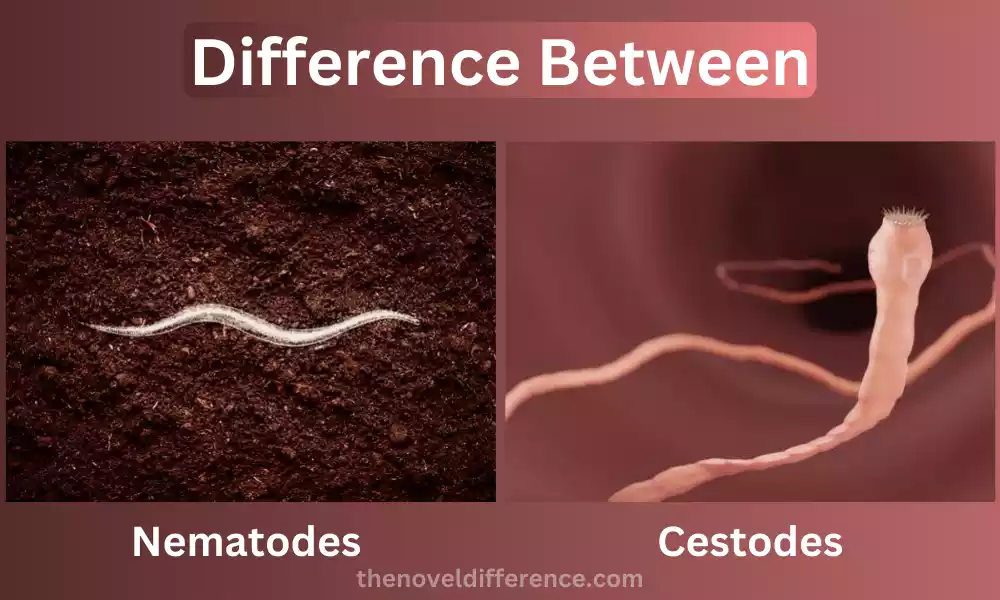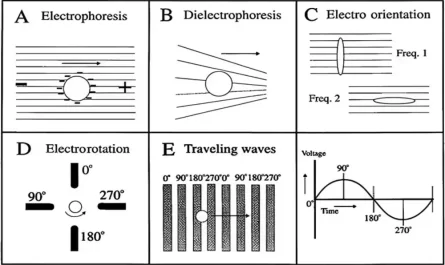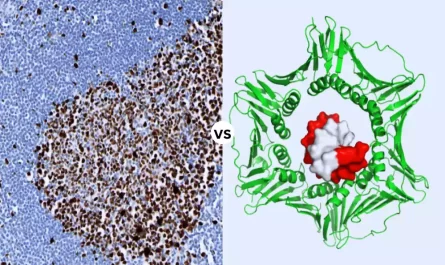Definition of Nematodes and Cestodes
Nematodes: Nematodes (also referred to as roundworms) belong to the Nematoda subphylum of animals. Earthworms are one of the most prolific and widespread multicellular organisms on our planet, found everywhere from the soil, freshwater environments, and marine environments to living inside other organisms as parasites.
Nematodes are unsegmented worms characterized by their elongated, cylindrical body shape, which tapers at both ends. They have a simple body plan, with a complete digestive system consisting of a mouth and an anus. Nematodes lack circulatory and respiratory systems, as they primarily rely on diffusion for gas exchange.
These organisms exhibit sexual dimorphism, with separate male and female individuals. Reproduction among nematodes may either be sexual or asexual depending on their species. Some nematodes have complex life cycles involving different stages, while others have more direct life cycles.
Nematodes play essential roles in various ecosystems as decomposers, predators, and parasites. Some species can provide essential contributions to nutrient cycling and soil health; others can cause immense harm by spreading disease outbreaks among plants, animals, and people alike.
Due to their ecological and economic importance, nematodes are currently studied extensively across fields like agriculture, medicine, and environmental science.
Cestodes: Cestodes, commonly known as tapeworms, are a type of parasitic flatworm belonging to the class Cestoda within the phylum Platyhelminthes. Humans, mammals, birds, fish, and reptiles all can become infected with parasites in their digestive systems and become susceptible to parasitic attacks as a result. We, humans, may also fall prey to such attacks from parasites invading our system.
Cestodes have a unique and specialized body structure adapted for a parasitic lifestyle. Unlike nematodes, they are long and ribbon-like, consisting of multiple segments called proglottids. Each proglottid contains reproductive structures, allowing them to reproduce and produce eggs independently.
The anterior end of a tapeworm, known as the scolex, bears hooks or suckers, which the parasite uses to attach itself to the intestinal wall of its host. From the scolex, the tapeworm grows longer by continuously adding new proglottids to its posterior end.
Cestodes lack a digestive system, and they absorb nutrients through their body surface. They rely on their host’s digestive system to obtain nutrients in a process that often causes malnutrition and weakness in the infected host.
The life cycle of cestodes typically involves intermediate hosts, such as various invertebrates, which ingest the tapeworm eggs. The eggs hatch inside the intermediate host, and the larvae develop into cysts.
When a definitive host (e.g., a human or other vertebrate) consumes the infected intermediate host, the tapeworm larvae are released in the host’s digestive tract and attach to the intestinal wall, starting the parasitic cycle once again.
Cestodes can cause various health issues in their hosts, ranging from mild discomfort to severe diseases. Human infections with tapeworms can be acquired by consuming undercooked or contaminated meat containing cysts or eggs.
Controlling and preventing cestode infections often involves proper cooking of meat, good hygiene practices, and deworming medications. Due to their impact on human and animal health, cestodes play an integral role in medicine, veterinary science, and public health studies.
Importance of understanding the difference between Nematodes and Cestodes
Nematodes and Cestodes are imperative for several reasons, as detailed here:
1. Disease Diagnosis and Treatment: Nematodes and cestodes can lead to various illnesses in humans, animals, and plants alike. Proper identification of the parasite involved is essential for accurate diagnosis and effective treatment. Different species of nematodes and cestodes require different approaches to manage infections, including the use of specific drugs and control measures.
2. Agricultural and Environmental Impact: Nematodes and cestodes can significantly impact agricultural productivity and the health of ecosystems. Nematodes can both benefit and damage crops. Understanding which species are present in a particular environment helps in implementing appropriate management strategies and reducing crop losses. In the case of cestodes, knowing their presence and life cycle in certain ecosystems helps in maintaining biodiversity and ecosystem balance.
3. Public Health Concerns: Some nematodes and cestodes are responsible for causing serious diseases in humans, such as intestinal infections and tissue damage. An understanding of parasite transmission routes, life cycles, and epidemiology are indispensable components to devising effective prevention and control measures for public health officials.
4. Veterinary Medicine: Both nematodes and cestodes can infect animals, affecting livestock productivity and causing health issues in pets and wildlife. Proper identification and understanding of these parasites aid veterinarians in diagnosing and treating infected animals.
5. Parasitology Research: Understanding the differences between nematodes and cestodes is essential for researchers studying parasitology, evolutionary biology, and ecology. These studies advance our knowledge of Earth’s biodiversity and complexity of life forms and may lead to new treatments and control methods being developed.
6. Conservation Efforts: Some nematodes and cestodes can infect endangered species, threatening their survival. By understanding the differences between these parasites, scientists can design conservation programs that consider potential parasite-related risks.
7. Control Strategies: Prevention and control of nematode and cestode infections often require different approaches. Knowledge of the specific characteristics, life cycles, and transmission patterns of these parasites allows for the development of targeted control strategies, reducing the risk of resistance development and minimizing environmental impacts.
Understanding the distinctions between nematodes and cestodes is critical for disease management, agriculture, public health, veterinary medicine research efforts, conservation initiatives, and conservation efforts. Knowledge allows us to make more informed decisions to safeguard both human health as well as ecosystem balance within ecosystems.
What are Nematodes?
Nematodes, more commonly referred to as roundworms, are members of the Nematoda phylum. Gophers are one of the world’s most abundant and widespread animals, found in virtually every environment imaginable from soil to water to animal tissues and even our own bodies. Nematodes come in various sizes, ranging from microscopic to several meters long.
Critical characteristics of nematodes include:
1. Body Shape: Nematodes possess elongated cylindrical bodies with tapering ends. They are unsegmented, meaning their bodies are not divided into distinct sections like other worms.
2. Cuticle: Their bodies are covered by a protective, flexible outer covering called the cuticle. The cuticle plays a crucial role in maintaining their shape and protecting them from environmental factors.
3. Digestive System: Nematodes possess an elaborate digestive system consisting of both an anterior-end mouth and a posterior-end anus. Food is ingested through the mouth and travels through a simple, straight gut for digestion and absorption of nutrients.
4. Nervous System: They possess a simple nervous system with nerve cords running along the body’s length, allowing them to respond to stimuli and coordinate basic behaviors.
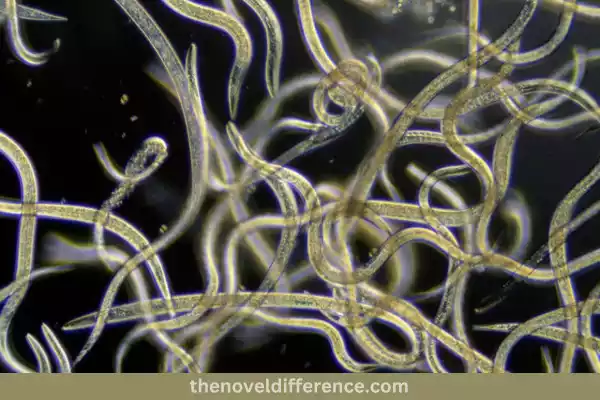
5. Reproduction: Nematodes exhibit sexual dimorphism, with separate male and female individuals. Some species possess both male and female reproductive systems for reproduction purposes, known as hermaphrodites. Reproduction can be sexual or asexual, depending on the species.
6. Habitat and Ecology: Nematodes can be found in virtually all habitats, from deep ocean trenches to high mountain soils. They play various ecological roles, including being important decomposers, predators of bacteria and fungi, and parasites of plants, animals, and humans.
7. Economic Significance: While many nematodes have beneficial roles in ecosystems, some are harmful pests in agriculture, causing significant damage to crops. Other entities can cause various diseases in both humans and animals.
8. Research Importance: Nematodes have become essential model organisms in scientific research, especially genetics and developmental biology. Their simple body plan and the transparency of some species make them useful for studying biological processes.
Due to their ecological significance and widespread distribution, nematodes have long been studied across disciplines like agriculture, medicine, ecology, and evolutionary biology. With an astonishing range of species found around Earth that makes for fascinating scientific investigation topics – making nematodes one of our best scientific lenses into life on Earth!
What are Cestodes?
Cestodes, more commonly referred to as tapeworms, belong to the subphylum Platyhelminthes. Unlike nematodes, which are cylindrical and unsegmented, cestodes have a unique body structure characterized by their elongated, ribbon-like shape composed of multiple segments called proglottids.
Critical characteristics of cestodes include:
1. Body Structure: The body of a tapeworm consists of a head region known as the scolex, which possesses specialized structures such as hooks or suckers. The scolex is used to attach the tapeworm to the intestinal lining of the host. From the scolex, the tapeworm grows elongated, adding new segments called proglottids along its length.
2. Proglottids: Proglottids are the repeated segments that make up the body of a tapeworm. Each proglottid contains reproductive organs, allowing tapeworms to produce eggs independently. As they mature, proglottids become filled with eggs and eventually detach from the worm, leaving the host’s body through feces.
3. Digestive System: Cestodes lack a true digestive system. Instead, they absorb nutrients through their body surface. This adaptation is a consequence of their parasitic lifestyle, as they absorb nutrients directly from the host’s intestinal contents.
4. Life Cycle: The life cycle of cestodes typically involves intermediate hosts, such as various invertebrates or vertebrates. Tapeworm eggs are released from proglottids into the environment through the host’s feces. When these eggs are ingested by intermediate hosts, they develop into larvae, which form cysts in the tissues of the intermediate host. The definitive host, often a vertebrate, becomes infected by consuming the intermediate host containing the cysts. Once inside the definitive host’s intestine, the tapeworm larvae are released and attach to the intestinal wall, continuing the life cycle.
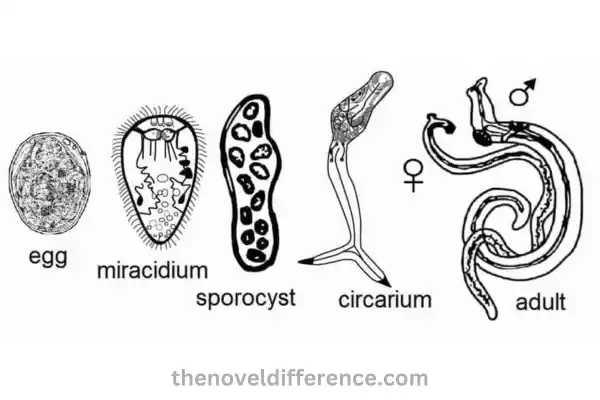
5. Parasitic Nature: Cestodes are obligate parasites, meaning they rely on a host organism to complete their life cycle. Piles of parasitic organisms inhabiting various vertebrate digestive tracts – humans, mammals, birds, fish, and reptiles among them.
6. Pathogenicity: Some cestode species can cause diseases in their hosts, resulting in health problems, malnutrition, and reduced productivity. Human infections with certain tapeworm species can lead to serious conditions, necessitating medical attention.
7. Economic and Veterinary Importance: Cestode infections can have significant economic implications in livestock industries due to reduced meat and milk production. In veterinary medicine, understanding cestodes is essential for diagnosing and managing parasite infections in animals.
8. Public Health Concerns: Cestodes that infect humans can be acquired through the consumption of undercooked or contaminated meat containing tapeworm larvae. Proper hygiene and cooking practices are essential to prevent human infections.
Cestodes are intriguing organisms with unique adaptations for parasitic living, and their study is crucial for understanding host-parasite interactions, public health issues, and ecosystem dynamics.
Impact of Nematodes and Cestodes on Humans, Animals, and Plants
Nematodes and cestodes can have significant impacts on humans, animals, and plants, both beneficial and detrimental.
Here’s an overview of their effects on each group:
1. Impact on Humans:
- Disease in Humans: Some nematodes and cestodes are responsible for causing diseases in humans, such as intestinal infections. For example, the roundworm Ascaris lumbricoides and the tapeworms Taenia solium and Taenia saginata can lead to serious health issues if left untreated. These infections often result from eating or drinking something contaminated, like food or water that contains pathogens that are inedible.
- Zoonotic Infections: Some parasitic nematodes and cestodes can be transmitted from animals to humans (zoonoses). For instance, humans can acquire the dog tapeworm Echinococcus granulosus from contact with infected dogs or contaminated environments. Zoonotic infections require proper control measures to prevent transmission.
- Medical Research: Nematodes like Caenorhabditis elegans have long been used as model organisms in medical research due to their easy anatomy and genetic tractability. Studying these organisms has provided valuable insights into various biological processes relevant to human health.
2. Impact on Animals:
- 1. Veterinary Diseases: Nematode infections, such as gastrointestinal worms in livestock, can cause economic losses in animal agriculture due to reduced growth rates, poor feed conversion, and impaired reproductive performance.
- 2. Parasitic Diseases: Cestodes can infect animals, including pets and wildlife, causing various parasitic diseases. For example, the tapeworm Dipylidium caninum commonly affects dogs and cats.
- 3. Zoonotic Risks: Some nematodes and cestodes affecting animals can pose a risk to human health if transmitted through close contact or consumption of undercooked meat.
3. Impact on Plants:
- Plant Parasitism: Some nematodes are plant parasites, feeding on plant tissues and causing damage to crops. Plant-parasitic nematodes can result in reduced yields and crop losses, affecting agriculture and food production.
- Soil Health: Nematodes play an indispensable role in soil ecosystems, contributing to nutrient cycling and decomposing organic matter. However, certain nematode species can negatively impact soil health by preying on beneficial organisms or transmitting plant pathogens.
4. Beneficial Impacts:
- Decomposers: Many nematodes contribute to the decomposition process, breaking down organic matter and recycling nutrients back into the ecosystem.
- Predators: Some nematodes are predators of bacteria and fungi, helping to regulate microbial populations in the soil.
- Biological Control: Certain nematodes are used in biological control strategies to manage pest populations in agriculture. For example, entomopathogenic nematodes target insect pests.
Nematodes and cestodes can have numerous ramifications on humans, animals, and plants – with both positive and negative consequences. Proper understanding and management of these organisms are essential for mitigating the negative effects and harnessing their beneficial roles in various ecosystems.
Control and Management of Nematodes and Cestodes Infestations
Control and management of nematode and cestode infestations require different strategies depending on their species, host organism, and specific circumstances.
Here are some common control strategies:
Control of Nematode Infestations:
- Crop Rotation: Implementing crop rotation practices can help break the life cycle of plant-parasitic nematodes, reducing their build-up in the soil. By alternating susceptible and non-susceptible crops, farmers can manage nematode populations naturally.
- Resistant Cultivars: Using nematode-resistant crop varieties can be an effective strategy to limit nematode damage in agricultural fields.
- Biological Control: Beneficial nematodes (entomopathogenic nematodes) have proven an effective biological control agent against insect pests, decreasing their numbers while simultaneously controlling soil populations directly or indirectly through increased soil nematode numbers.
- Nematicides: Chemical nematicides are available for controlling nematodes in agriculture. However, their use should be judicious to avoid environmental contamination and the development of resistance.
- Soil Amendments: Some organic soil amendments, such as compost or certain biofumigant crops, have been shown to suppress nematode populations.
Control of Cestode Infestations:
- Veterinary Medications: For cestode infestations in animals, such as dogs and cats, specific anthelmintic medications are available. These medications target and eliminate adult tapeworms from the host’s intestines.
- Proper Cooking: To prevent human cestode infections, it is essential to cook meat thoroughly, especially pork and beef, to kill any potential cysts containing tapeworm larvae.
- Hygiene Practices: Ensuring proper hygiene, such as washing hands before handling food and maintaining cleanliness around pets, can minimize the risk of zoonotic cestode infections.
- Avoiding Raw or Undercooked Seafood: Some cestodes, like fish tapeworms, can be transmitted to humans through raw or undercooked seafood. Properly cooking seafood is crucial to avoid infections.
- Deworming Pets: Regular deworming of pets, especially dogs and cats, helps prevent the spread of tapeworms and other intestinal parasites to humans and other animals.
- Wildlife Management: In some cases, controlling cestode infections in wildlife populations can be important for preventing the transmission of parasites to domestic animals and humans.
Integrated Pest Management (IPM):
Nematode and cestode infestations should be managed using integrated pest management (IPM). This approach involves employing multiple control tactics in tandem. IPM involves combining multiple strategies to manage pests effectively while minimizing environmental impact. IPM strategies may include a combination of biological control, cultural practices, resistant cultivars, and targeted chemical interventions.
It’s important to note that control measures should be tailored to specific situations and follow recommended guidelines to ensure effective and sustainable management of nematode and cestode infestations.
Additionally, proper surveillance, monitoring, and regular evaluations are essential to detect and address any changes in pest populations and their susceptibility to control measures.
What is the difference between Nematodes and Cestodes?
Nematodes and cestodes are two distinct groups of worms with notable differences in their characteristics, anatomy, life cycles, and impact on hosts.
Here are the key differences between nematodes and cestodes:
1. Body Shape and Structure:
Nematodes: Nematodes have a cylindrical, elongated body with two tapering ends and slight convexities on either end. They are unsegmented, meaning their bodies are not divided into distinct segments or sections.
Cestodes: Cestodes have an elongated, ribbon-like body shape composed of multiple segments called proglottids. Their bodies are divided into repeated segments, and each proglottid contains reproductive organs.
2. Digestive System:
Nematodes: Nematodes possess an integrated digestive system consisting of both an anterior-end mouth and a posterior-end anus. They ingest food through the mouth and pass it through a simple, straight gut for digestion and nutrient absorption.
Cestodes: Cestodes lack a true digestive system. They do not have a mouth or gut for digesting food. Instead, they absorb nutrients directly through their body surface from the host’s intestinal contents.
3. Nervous System:
Nematodes: Nematodes have a simple nervous system with nerve cords running along their body length. They possess sensory structures that allow them to respond to environmental stimuli.
Cestodes: Cestodes have a less complex nervous system compared to nematodes, but they still exhibit some sensory structures in their scolex, which is the anterior end used for attachment to the host’s intestinal wall.
4. Reproductive System:
Nematodes: Nematodes exhibit sexual dimorphism, meaning they have separate male and female individuals. Some species have both male and female reproductive systems. This means that they can reproduce both as males and females. Reproduction can be sexual or asexual, depending on the species.
Cestodes: Cestodes are hermaphroditic, with each proglottid containing both male and female reproductive organs. They can produce thousands to millions of eggs independently, which are released into the environment through the feces of the definitive host.
5. Habitat:
Nematodes: Nematodes can be found almost everywhere from soil and water environments, to animals such as humans. Some are free-living, while others are parasitic.
Cestodes: Cestodes are obligate parasites of vertebrates. These parasites often inhabit the digestive systems of various animals including humans, mammals, birds, fish, and reptiles.
6. Impact on Hosts:
Nematodes: Some nematodes are beneficial, contributing to nutrient cycling and soil health, while others can be harmful pests in agriculture or cause diseases in humans and animals.
Cestodes: Cestodes are parasites that can cause various health issues in their hosts, including reduced nutrient absorption, malnutrition, and tissue damage. They are particularly well-known for tapeworm infections in humans and animals.
Nematodes and cestodes differ mainly in their body shapes, digestive systems, nervous systems, reproductive systems, habitat needs, and effects on hosts. These differences are crucial for proper identification, understanding of their biology, and developing effective control and management strategies.
What are the similarities between Nematodes and Cestodes?
Despite their distinct differences, nematodes and cestodes also share some similarities, particularly in their classification as parasitic organisms and their ecological roles.
Here are the key similarities between nematodes and cestodes:
- Parasitic Lifestyle: Nematodes and cestodes are parasitic organisms that rely on hosts for survival and reproduction. Animals, plants, and humans host microbes that feed off of nutrients in order to complete their life cycles and fulfill their survival requirements.
- Veterinary and Medical Significance: Nematodes and cestodes have significant veterinary and medical importance. They can cause diseases and health issues in both animals and humans. Parasitic infections with these worms can lead to malnutrition, tissue damage, and other health complications, requiring proper diagnosis and treatment.
- Zoonotic Potential: Some nematodes and cestodes have zoonotic potential, meaning they can be transmitted between animals and humans. Infection in one species may pose risks to other species, highlighting the importance of proper hygiene and preventive measures.
- Life Cycle Complexity: Both nematodes and cestodes have complex life cycles that often involve multiple hosts. They require specific intermediate hosts to complete their life cycle and eventually reach their definitive host, where they reproduce and produce eggs.
- Economic Impact: Nematodes and cestodes can have significant economic impacts, especially in agriculture. Plant-parasitic nematodes can cause crop losses and reduce agricultural productivity, while cestodes can affect livestock and result in economic losses in animal production.
- Environmental Significance: Both nematodes and cestodes play essential roles in ecosystem functioning. Nematodes, as decomposers and predators, contribute to nutrient cycling and soil health. Cestodes are part of the complex food webs in which they interact with other organisms.
- Biological Control: In certain situations, nematodes and cestodes can be employed as biological control agents. For instance, some nematodes are used as biological control agents against insect pests, while cestodes can help regulate the populations of intermediate hosts in certain ecosystems.
- Model Organisms: Both nematodes and cestodes have been used as model organisms in scientific research. Caenorhabditis Elegans has proven indispensable in various scientific areas such as genetics, developmental science, and neuroscience research.
While nematodes and cestodes have their unique characteristics and ecological roles, these similarities illustrate their broader importance in various aspects of biology, medicine, agriculture, and ecology. Understanding these shared features helps scientists and researchers in their study of these parasitic organisms and their impact on the natural world.
Research and Discoveries Related to Nematodes and Cestodes
Research into nematodes and cestodes has been ongoing, yielding substantial discoveries and advancements across numerous fields of science.
Here are a few noteworthy research areas and findings related to nematodes and cestodes:
1. Genetics and Developmental Biology:
Caenorhabditis elegans: Elegans have been extensively studied as a model organisms for genetics and developmental biology. In 2002, Sydney Brenner, H. Robert Horvitz, and John E. Sulston were awarded the Nobel Prize in Physiology or Medicine for their work involving genetic control of organ development and programmed cell death using C.elegans.
2. Parasitology and Disease Control:
Antiparasitic Drugs: Research efforts have led to the developing of various antiparasitic drugs to treat nematode and cestode infections in humans and animals, improving disease control and patient outcomes.
Drug Resistance: Ongoing research is focused on understanding drug resistance mechanisms in nematodes and cestodes to develop strategies for preventing and managing resistance.
3. Agricultural Impact:
Plant-Parasitic Nematodes: Research on plant parasitic nematodes has led to significant advances in our understanding of their biology and damage mechanisms; as well as to sustainable management solutions designed to minimize crop losses.
Biological Control: Studies have explored the use of beneficial nematodes as biological control agents against insect pests and other nematode species.
Public Health and Zoonotic Infections:
Zoonotic Cestode Infections: Studies on the epidemiology, transmission, and prevention of Echinococcus or Taenia cestode infections have been undertaken extensively.
Control Strategies: Studies have focused on developing control strategies to prevent cestode infections in both human and animal populations.
4. Evolutionary Biology:
Phylogenetics: Recent advances in molecular techniques have allowed researchers to analyze the evolutionary histories of various nematode and cestode species, providing a more in-depth analysis of their phylogeny.
Comparative Genomics: Comparative genomics studies have provided novel insight into the genetic basis behind adaptations, reproductive strategies, and host-parasite interactions found among nematodes and cestodes.
5. Ecological Significance:
Soil Ecology: Studies of nematodes’ role in soil ecosystems have focused heavily on their interactions with other organisms as well as any effects they might have on nutrient cycling and ecological wellbeing.
Parasite Ecological Interactions: Studies have investigated the ecological interactions of cestodes with intermediate hosts, their effects on host populations, and the dynamics of parasite transmission in ecosystems.
6. Diagnostic Methods:
Molecular Techniques: Advances in molecular diagnostic methods have improved the accuracy and efficiency of identifying nematode and cestode species, aiding in disease diagnosis and surveillance.
Research areas focused on nematodes have greatly expanded our knowledge while simultaneously having wide-reaching impacts in terms of human health, agriculture, ecology, and environmental conservation. Research continues to shed valuable insight into these parasitic organisms that cause destruction to nature.
Conclusion
Nematodes and cestodes are fascinating organisms that belong to distinct groups within the animal kingdom. Nematodes are roundworms with an elongated, unsegmented body, while cestodes are tapeworms characterized by their ribbon-like bodies composed of repeated segments called proglottids.
Despite their differences, both nematodes and cestodes play significant roles in various ecosystems and can have both beneficial and detrimental impacts on humans, animals, and plants.
Research on nematodes and cestodes has been instrumental in advancing fields such as genetics, developmental biology, parasitology, agriculture, and public health.

